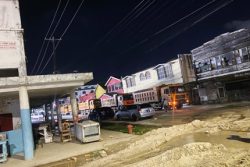Recently I paid a visit to Trinidad and while there made a remarkable discovery. I was invited to the Queens Park Cricket Club which in my youth had been a favourite place. Great uncles on my mother’s side of the family had been founding members of that famous Club and as a boy I went there to see our West Indian cricket heroes play. Sweet are the memories. The Oval in sunlight. The green mountains in the background. The buzz of excitement in the schoolboys’ stand and the quiet, quiet as the first ball bowled. I remember seeing Andy Ganteaume make his famous century against England in 1948 in the only Test innings he was ever allowed to play. I remember the grace of Worrell, the thunder of Walcott, the elegance of Stollmeyer, Robert Christiani dancing down the pitch to hit boundary after boundary, the wiles of Ferguson, the deftness of Rupert Tang Choon in the field, the fast bowling of Lance Pierre smooth as velvet. So many heroes. So many memories came back as I visited after so long.
I found the QPCC completely changed, expanded, modernized, transformed since I was a boy. I talked to the CEO, Richard Mowser, and was shown around. It is a vibrant place, humming with activity, a centre of cricket but also an important venue for hockey, football, squash and I think I saw a notice advertising CrossFit training. The Club is practical about raising money by letting out its excellent facilities and it shows every sign of being a well-run commercial enterprise which Clubs have to be these days. With cricket at its heart still, long may Queens Park evolve and thrive.
But I was there primarily to visit the QPCC Cricket Heritage Museum. Before my visit I had not even known this museum existed. Quite simply, it is a marvel, a revelation, a place every West Indian cricket lover should find the time to visit and be enthralled. I spent a few glorious hours there in the company of the museum’s Curator, Stephen Almandoz, who does the job for the love of his Club and the game. His talk is fascinating – he himself is a wondrous storehouse of cricketing knowledge and history and folklore – and the museum he tends so lovingly is an endlessly interesting display of Club and Trinidad, but also West Indies, cricket memorabilia.
 I hardly know where to start in describing the treasures. There are the founding documents of the Club, the original leases, the old minute books. There are the scorecards of yesteryear, plaques for honours won and medals and scores of trophies in their cases. There are the hundreds and hundreds of photographs going back a hundred years, some indeed dating from 1896 when the Club was founded. There is an original turnstile from the entrance to the Club through which passed spectators since the start. There is the actual piece of the pitch for the 50th Test match played at the Oval – along with the balls used by both teams – West Indies and South Africa – with one set markedly more battered than the other!
I hardly know where to start in describing the treasures. There are the founding documents of the Club, the original leases, the old minute books. There are the scorecards of yesteryear, plaques for honours won and medals and scores of trophies in their cases. There are the hundreds and hundreds of photographs going back a hundred years, some indeed dating from 1896 when the Club was founded. There is an original turnstile from the entrance to the Club through which passed spectators since the start. There is the actual piece of the pitch for the 50th Test match played at the Oval – along with the balls used by both teams – West Indies and South Africa – with one set markedly more battered than the other!
Stephen Almandoz described to me how he discovered in what he called “the dungeon” an immense box he called “the coffin” in which were found ancient pimpled-rubber gloves and bats and wickets and programmes going back to the 1920s and caps and jackets and scrolls. And he inherited the memorabilia of men like Gerry Gomez and Phillip Thomson, priceless cornucopias belonging to men who loved the game and, in the case of Gerry, had played it to the hilt at the highest level. The museum grew and grew. Former players bequeathed and loaned astonishing items. In a special case you can see the three bats, with the red splashes on their blades, which Brian Lara used to score his world records: 375, 501 not out and 400 not out – “divine pieces of willow” indeed. I stayed a while and worshipped at that shrine.
The Cricket Museum is wonderful to see. The Gods of cricket must look down in joy. And Stephen Almandoz tells me that only a tenth of all the pictures, books and memorabilia he has collected is on display. Never mind. What is not seen is safely kept for an even more glorious future.
What also is important is that the museum is very much a repository of West Indies cricket history. It is a regional cricket treasure house. Guyana cricketing heroes and teams, for instance, feature prominently on the walls and in the display cases. I was astonished and pleased to see a lovely piece of sculpture, depicting Batsman and Bowler, on display – it is the work of one of our own master artists, Winslow Craig. As I wandered around in that remarkable trove of cricket history and listened to the Curator’s enthralling commentary I thought what an outstanding act of preservation and presentation has been accomplished. I went to the bar afterwards with Stephen Almandoz and Richard Mowser and was happy to raise quite a few toasts to the Club’s future and to its world-class Cricket Museum. And I am glad to say that to do so the best Guyanese rums were very much available.
Returning home to Guyana, I reflected on my experience at the Queens Park Cricket Club. What has been achieved there in preserving the history of West Indies cricket is extraordinary. The tremendous, ongoing effort to identify, collect, store, document and display this important part of our heritage – this “imaginative possession” belonging to us all – is worthy of heartfelt praise. I came away with a feeling of excitement and a sense of pride. And so at home my attention naturally turned to another Club as famous as, and considerably older than, the Queens Park. Just down the road. The Georgetown Cricket Club. The GCC. Bourda. I have been a member there for nearly 60 years, I think I may be the longest standing member, but lately I have hardly gone there. So many memories of that hallowed cricket ground. So many historical snapshots in my mind. Perhaps it is time I pay a visit and see what is happening there … But then again, perhaps not.








